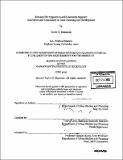Between hot opposition and lukewarm support : innovation and community in land planning and development
Author(s)
Mammen, Taylor G
DownloadFull printable version (34.82Mb)
Alternative title
Innovation and community in land planning and development
Other Contributors
Massachusetts Institute of Technology. Dept. of Urban Studies and Planning.
Advisor
David Laws.
Terms of use
Metadata
Show full item recordAbstract
Research on two innovative developments in the Mountain West region of the United States validates an argument by Donald Schon that effective "coordination of conflicting frames" represents a "more promising line of attack" on the numerous issues that challenge land planners and developers. This process, which Lester and Piore call "interpretation," moves beyond mere "problem setting and solving" to make space for the occurrence of novelty, or innovation. These innovative responses to problems may not guarantee ideal solutions, but stand the chance of allowing for important improvements. Specifically, the case histories suggest that the interpretive process arises because the developments' proponents, either out of necessity or by design, embraced a more open-ended planning process and commitment to broader collaboration than typically seen in land planning and development. Not surprisingly, these points confirm that novel ideas in land planning and development come about for largely the same reasons that they do in any endeavor. (cont.) However, because of significant constraints on alternative land use patterns from both the supply and demand sides of the market, as well as from the government, the implementation of innovation in land planning and development depends upon the advocacy of a community devoted to it. Such communities are born from Lester and Piore's process of interpretation, and in turn come to be important advocates: they help to overcome opposition and serve as a continuing source of ideas and inspiration, often pushing the innovation beyond original expectations. The recommendations that follow therefore emphasize changes to practice - both incremental and radical - that make effective use of the distributed knowledge, power, and expertise represented within these communities of innovation.
Description
Thesis (M.C.P.)--Massachusetts Institute of Technology, Dept. of Urban Studies and Planning, 2006. Includes bibliographical references (p. 115-120).
Date issued
2006Department
Massachusetts Institute of Technology. Department of Urban Studies and PlanningPublisher
Massachusetts Institute of Technology
Keywords
Urban Studies and Planning.